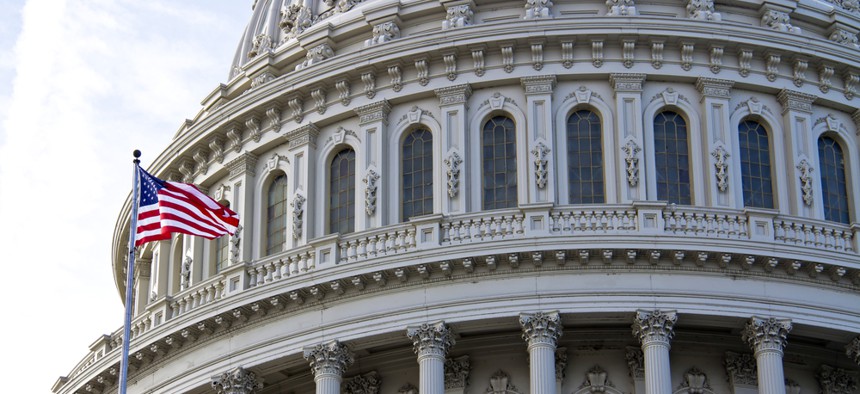
Mesut Dogan/Shutterstock.com
Stacked Deck
Democrats have it tough in Senate races this year; the GOP is looking at an even worse scenario in 2016.
While the outcomes of presidential races are pretty much decided by how the swing, or "purple," states split, in the fight for control of the U.S. Senate that is not always the case. The challenge for Democrats in this election is having so many seats up in very Republican states. Seven of those seats are in states carried by Mitt Romney, and—tougher still—six of the seven are states Romney carried by 14 points or more.
The challenge currently facing Democrats will likely be mirrored on the GOP side in 2016, when the Republicans have 24 Senate seats up, to only 10 for the Democrats. Seven of those 24 GOP seats are in states that President Obama won in 2012, and five are in states that he won by 5 points or more.
In Illinois, Mark Kirk will face voters in a state that Obama won by 17 points. Ron Johnson in Wisconsin will be running in a state where Obama prevailed by 7 points. Both Kelly Ayotte in New Hampshire and Chuck Grassley in Iowa will have races in states that Obama won by 6 points. Pat Toomey in Pennsylvania will be running in a state Obama won by 5 points. Ohio's Rob Portman will be up in a state Obama won by 3 points. Marco Rubio is up in Florida, which Obama won by 1 point.
While not all of those senators will necessarily seek reelection—Grassley, for example, will turn 83 in 2016—these aren't great states for Republicans in general, and in a presidential election year there will probably be a larger and more Democratic voter turnout. That is very unlike what we expect to see this year, when a smaller, older, whiter, more conservative, and Republican-leaning midterm electorate will likely put a thumb on the scale for the GOP.
While I was doing a dog-and-pony show the other day with my good friend and competitor Stuart Rothenberg, he made the excellent point that if Republicans do pick up a Senate majority this year, their governing challenge will be keeping some of their fellow Republicans in line—those who know they will eventually be facing voters who don't always fall in lockstep behind all of the goals and aspirations of the GOP. As a result, the Republican agenda, should the party win a majority this year, might not be as aggressively conservative as some in the party would hope.
This is the new political world we live in, as pointed out by a fascinating report on political polarization published in June by the Pew Research Center. The Pew team that wrote the report, headed by Michael Dimock, asserted that "Republicans and Democrats are more divided along ideological lines—and partisan antipathy is deeper and more extensive—than at any point in the last two decades." The share of Americans who express "more consistently conservative or consistently liberal opinions" has more than doubled over the last 20 years, from 10 percent to 21 percent of the electorate, and ideological thinking is more consistent with partisanship than before.
The researchers found that 92 percent of Republicans are more conservative than the median Democrat and 94 percent of Democrats are more liberal than the median Republican. Along with this greater ideological and partisan cohesion, Pew also finds that partisan animosity has doubled since 1994. According to the report, "Most of these intense partisans believe the opposing party's policies are so misguided that they threaten the nation's well-being."
The end result of this new political world is that it is far more difficult for incumbents to survive if they are outside the ideological box of their own party or state. This year, it is Democrats Mark Begich in Alaska, Mark Pryor in Arkansas, and Mary Landrieu in Louisiana who are trying to survive in states where there are few conservative and moderate Democrats left, and even fewer Republicans willing to break ranks to support someone not wearing a GOP jersey. Two years from now, it will be Republicans in this position, as not a single Democrat will be up in a state that Mitt Romney carried in 2012.
If this year's Senate races were largely being fought in purple, swing, light-blue, or softly Democratic states, Democrats would still likely lose a few seats. They could easily lose the open seat in Iowa, as well as Mark Udall's race in Colorado, but it is unlikely they would be in as much danger of losing their Senate majority as they are now. Democrats simply have so many blue seats up in red states such as Montana, South Dakota, and West Virginia—in addition to the highly vulnerable Begich, Landrieu, and Pryor.
That's why Republicans don't necessarily need a wave to win a majority. They just need red states to stay red.
This article appears in the October 4, 2014 edition of National Journal Magazineas Stacked Deck.
(Image via Mesut Dogan/Shutterstock.com)
NEXT STORY: Bobby Jindal Joins the GOP Hawks






